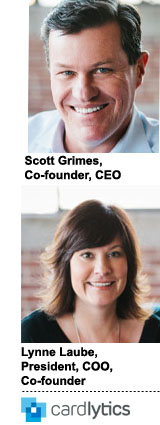
It’s IPO day for Cardlytics, the maker of an analytics platform that leverages purchase data sourced directly from bank partners.
Cardlytics began trading at about $12, below its target share price of $13-$15, when Nasdaq opened Friday, before climbing modestly to $13 in afternoon trading. Cardlytics aims to raise about $70 million in the offering.
AdExchanger asked Cardlytics’ co-founders, CEO Scott Grimes and President and COO Lynne Laube, what’s next for advertisers as the company makes its public market debut.
AdExchanger: This is a tough climate for ad and marketing tech companies. How would you describe your experience going public?
SCOTT GRIMES: We’ve obviously been out raising money in a challenging environment, and thankfully we have a fantastic stable of long-term investors who understand our mission and get what we’re trying to accomplish. They understood the strength of the moat we built with our bank partners, and how the media we drive through the native bank channel … helps drive a guaranteed return on advertising budgets.
What do you mean?
Grimes: We use people’s prior purchase history to understand when they’re likely to be interested in a new feature or product. Because we see the purchase history before and after a marketing event, particularly a marketing event in the native banking channel, we can close the loop on purchases to see what drives consumers into stores, not just online.
You both came out of banking. How did this influence Cardlytics’ value prop?
Grimes: We were both executives at Capital One and we saw two things going on in the banking world then. One was this rapid growth of electronic payments, which are a clear indicator of how consumers spend money. Second was the growth of mobile banking, and we wanted to turn those channels into a way to engage with customers.
What’s one thing that surprises advertisers about Cardlytics?
LYNNE LAUBE: I don’t think a lot of advertisers fully understand how engaged consumers are with online banking and why it’s such a unique channel. The reason customers are logging into online banking eight times a month and mobile banking 23 times a month, which is what they’re doing in our networks, is because they’re thinking about their money and they’re logging in often to see if they have enough money to go out to eat tonight or to buy a pair of shoes.
Our click rates are 7% on average, which is an order of magnitude larger than any other digital channel out there. It’s an engaging place to talk to people about spending.
Who is Cardlytics’ end customer? Do you work with CPGs?
Grimes: While we know a whole lot about the stores and restaurants people are going to, we don’t have a lot of visibility into what people buy when they’re in the store today.
Our footprint taps much more into the market of retailers and restaurants, less around CPGs. That being said, we have many large ecommerce advertisers. While we’re good at getting people into stores, we’re also really good at driving people to websites.
Cardlytics has a lot of stake in one particular bank partner, Bank of America. What are you doing to diversify?
Laube: Bank of America is one of our oldest bank partners. We’ve worked with them since 2010, but it’s much more than a contractual relationship. They’re a great partner and we’re deeply embedded inside all of their channels, including online and mobile banking.
We recently developed an email product with them where customers can get their offers via email and activate without having to log in to mobile banking.
They are about 50% of our MAUs today, but we also recently announced a pilot with Wells Fargo, which should help reduce some of that concentration if we do our jobs well. We have great relationships with all of our banks; many are starting to understand the opportunity for them to collectively create a scaled media platform.
Interview condensed and lightly edited.
 Credit: Kelsey Ayres, Nasdaq, Inc.This post was syndicated from Ad Exchanger.
Credit: Kelsey Ayres, Nasdaq, Inc.This post was syndicated from Ad Exchanger.

More Stories
How Brands and Cannabis Companies Are Maximizing Their Joint Efforts for 420 Marketing
Meta’s ‘Pay Or OK’ Is A No-Go; Walmart Joins The Conquestor Club
Cannabis Clinic lights up 420 Day with debut billboards